INSTITUT SUPERIEUR D'ANTHROPOLOGIE
INSTITUTE OF ANTHROPOLOGY
ONLINE COURSES / COURS A DISTANCE
FALL TERM : OCTOBER 2014
REGISTER NOW
GRECE –  Zakynthos - A 16th century shipwreck that had been located in the 80s two kilometers off the port of Zakynthos island will be again in the focus of Culture Ministry's archaeologists studies. The 20-meter-long, vessel that shipwrecked near the port of Zakynthos in the Ionian Sea most likely participated in the 1571 Naval Battle of Nafpaktos, one of the most important sea battles in world history. The shipwreck, the only one discovered in Greece that dates back to the era of Philip II of Spain, was found in the 1980s by local speargun fishermen and in the 1990s it was studied by Greek archeologists in cooperation with Oxford University scientists. The part of its hull that was pulled out of the sea has been covered by geotextile to protect it from being eaten away by worms within the framework of an innovative method created by the Athens’ technological educational institutes (TEI). However, the research has been interrupted four years ago. The archaeologists will stay on Zakynthos for approximately a month while in the research team participate divers that will dive in the area of the shipwreck in order to find and reveal the other part of the ship that is still under tons of mud.
Zakynthos - A 16th century shipwreck that had been located in the 80s two kilometers off the port of Zakynthos island will be again in the focus of Culture Ministry's archaeologists studies. The 20-meter-long, vessel that shipwrecked near the port of Zakynthos in the Ionian Sea most likely participated in the 1571 Naval Battle of Nafpaktos, one of the most important sea battles in world history. The shipwreck, the only one discovered in Greece that dates back to the era of Philip II of Spain, was found in the 1980s by local speargun fishermen and in the 1990s it was studied by Greek archeologists in cooperation with Oxford University scientists. The part of its hull that was pulled out of the sea has been covered by geotextile to protect it from being eaten away by worms within the framework of an innovative method created by the Athens’ technological educational institutes (TEI). However, the research has been interrupted four years ago. The archaeologists will stay on Zakynthos for approximately a month while in the research team participate divers that will dive in the area of the shipwreck in order to find and reveal the other part of the ship that is still under tons of mud.
http://www.amna.gr/english//index.php/articleview.php?id=6968
FRANCE – 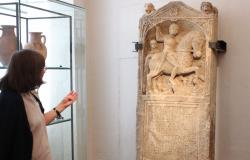 Strasbourg - C’est «Le» faubourg romain de Strasbourg. À l’époque gallo-romaine, l’artère principale de Koenigshoffen, actuelle route des Romains, était un îlot d’habitations, d’ateliers de productions de céramiques, de vie. Un diagnostic réalisé par l’Inrap (Institut national de recherches archéologiques préventives) en 2012 avait démontré la présence de nombreux vestiges comme une stèle haute de deux mètres attestant la présence de cavaliers auxiliaires dans le camp légionnaire de Strasbourg.Trouvée dans un état exceptionnel, elle est exposée depuis au musée archéologique de Strasbourg.Dans le cadre du projet de réaménagement de l’entrée du quartier, les fouilles qui vont s’étendre sur 8.000 m2 vont durer un an. «Un chantier exceptionnel selon Matthieu Kuchler, directeur du Pair (Pôle d’archéologie interdépartemental Rhénan) à qui a été confié la maîtrise d’art. On s’attend à de nombreuses découvertes».
Strasbourg - C’est «Le» faubourg romain de Strasbourg. À l’époque gallo-romaine, l’artère principale de Koenigshoffen, actuelle route des Romains, était un îlot d’habitations, d’ateliers de productions de céramiques, de vie. Un diagnostic réalisé par l’Inrap (Institut national de recherches archéologiques préventives) en 2012 avait démontré la présence de nombreux vestiges comme une stèle haute de deux mètres attestant la présence de cavaliers auxiliaires dans le camp légionnaire de Strasbourg.Trouvée dans un état exceptionnel, elle est exposée depuis au musée archéologique de Strasbourg.Dans le cadre du projet de réaménagement de l’entrée du quartier, les fouilles qui vont s’étendre sur 8.000 m2 vont durer un an. «Un chantier exceptionnel selon Matthieu Kuchler, directeur du Pair (Pôle d’archéologie interdépartemental Rhénan) à qui a été confié la maîtrise d’art. On s’attend à de nombreuses découvertes».
http://www.20minutes.fr/strasbourg/1440715-20140910-strasbourg-site-archeologique-8000-m2-ouvert-tous
FRANCE – 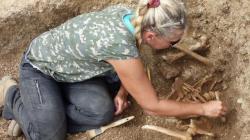 Benet - Pendant deux semaines, une équipe de l'Inra (Institut national des recherches archéologiques) a effectué une opération de diagnostic archéologique sur le site de l'ancien garage Fortin (entre la rue des Tombeaux et la rue de la Combe) et, en l'occurrence, préalable à un projet de construction de la commune. « Nous avons une accumulation très importante de tombes sur plusieurs siècles. Près de la rue sous le garage démoli, on retrouve à faible profondeur des sépultures et en particulier des sarcophages en calcaire qui correspondent à la phase la plus ancienne du cimetière pour ce secteur, à savoir la première moitié du Moyen Âge, entre le VIIe et le Xe siècle, souligne Véronique Gallien. C'est un vrai cimetière paroissial mis en place au début du Moyen Âge. Autour de l'église, il y a jusqu'à sept niveaux de tombes. »
Benet - Pendant deux semaines, une équipe de l'Inra (Institut national des recherches archéologiques) a effectué une opération de diagnostic archéologique sur le site de l'ancien garage Fortin (entre la rue des Tombeaux et la rue de la Combe) et, en l'occurrence, préalable à un projet de construction de la commune. « Nous avons une accumulation très importante de tombes sur plusieurs siècles. Près de la rue sous le garage démoli, on retrouve à faible profondeur des sépultures et en particulier des sarcophages en calcaire qui correspondent à la phase la plus ancienne du cimetière pour ce secteur, à savoir la première moitié du Moyen Âge, entre le VIIe et le Xe siècle, souligne Véronique Gallien. C'est un vrai cimetière paroissial mis en place au début du Moyen Âge. Autour de l'église, il y a jusqu'à sept niveaux de tombes. »
http://www.ouest-france.fr/archeologie-un-cimetiere-paroissial-mis-au-jour-2824394
RUSSIE – 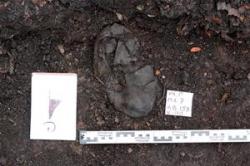 Staraya Russa - Staraya Russa, until the 16th century also known as "Rusa", was the largest medieval centre of trade and business in the southern region of Lake Ilmen."Archaeological research conducted in the historic centre of the city, in the trench, where the depth of cultural layers reached about 6 m. Archaeological monuments acquired in the course of research from the Novgorod land represent a unique source of knowledge about the region's past" - told PAP Dr. Magdalena Przysiężna - Pizarska, head of the Polish group. During excavations they uncovered many ceramic and wooded objects made in the Middle Ages. They also found everyday objects made of bone, including a comb, knife handles, and fabrics: felt, wool and silk. Among the metal objects, coins were the largest group. "For many students this was a unique opportunity to see incredibly well preserved fragments of objects made of leather, including hand-sewn, openwork, cut footwear. Unusual event was the discovery of silver objects: a beautifully decorated ring and silver framing, probably of a box, which housed an icon" - said Dr. Przysiężna – Pizarska. This year, between 14 and 28 July, the archaeologists reached the layers from the 14th, 15th and 19th centuries. Scientists are hoping that next season they will explore the layers formed in the 11th century, thus shedding light on the origins of this important urban centre.
Staraya Russa - Staraya Russa, until the 16th century also known as "Rusa", was the largest medieval centre of trade and business in the southern region of Lake Ilmen."Archaeological research conducted in the historic centre of the city, in the trench, where the depth of cultural layers reached about 6 m. Archaeological monuments acquired in the course of research from the Novgorod land represent a unique source of knowledge about the region's past" - told PAP Dr. Magdalena Przysiężna - Pizarska, head of the Polish group. During excavations they uncovered many ceramic and wooded objects made in the Middle Ages. They also found everyday objects made of bone, including a comb, knife handles, and fabrics: felt, wool and silk. Among the metal objects, coins were the largest group. "For many students this was a unique opportunity to see incredibly well preserved fragments of objects made of leather, including hand-sewn, openwork, cut footwear. Unusual event was the discovery of silver objects: a beautifully decorated ring and silver framing, probably of a box, which housed an icon" - said Dr. Przysiężna – Pizarska. This year, between 14 and 28 July, the archaeologists reached the layers from the 14th, 15th and 19th centuries. Scientists are hoping that next season they will explore the layers formed in the 11th century, thus shedding light on the origins of this important urban centre.
http://www.naukawpolsce.pap.pl/en/news/news,401755,opole-archaeologists-returned-from-russia.html
ROYAUME UNI – 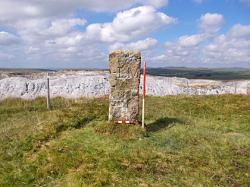 Emmet's Post- Emmet's Post, named after one of several pillars built to divide Lee and Shaugh Moors in 1835, is being investigated as part of a government-approved quarry expansion on the edge of Dartmoor. The mound of the post, on the boundaries of a china clay pit, was confirmed as a Bronze Age bowl barrow during a dig in 2011. ‘The barrow at Emmets Post, with its slightly hollowed-out top, is not the best-preserved of these Bronze Age monuments,” said Andrew Josephs, an archaeologist for Sibelco, the minerals firm paying for the project. “The excavation has the potential to further characterise the full extent of the barrow and potential ditch, possibly identifying buried surface deposits and phased construction horizons. “Environmental remains will add to the regional studies of the wooded prehistoric landscape that was very different to that today.”
Emmet's Post- Emmet's Post, named after one of several pillars built to divide Lee and Shaugh Moors in 1835, is being investigated as part of a government-approved quarry expansion on the edge of Dartmoor. The mound of the post, on the boundaries of a china clay pit, was confirmed as a Bronze Age bowl barrow during a dig in 2011. ‘The barrow at Emmets Post, with its slightly hollowed-out top, is not the best-preserved of these Bronze Age monuments,” said Andrew Josephs, an archaeologist for Sibelco, the minerals firm paying for the project. “The excavation has the potential to further characterise the full extent of the barrow and potential ditch, possibly identifying buried surface deposits and phased construction horizons. “Environmental remains will add to the regional studies of the wooded prehistoric landscape that was very different to that today.”
http://www.culture24.org.uk/history-and-heritage/archaeology/art499019-Public-invited-to-see-excavation-of-4000-year-old-bronze-age-barrow-on-dartmoor-edge
ROYAUME UNI – 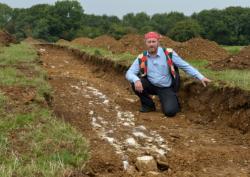 St Rumbold’s Well - An archaeological dig has unearthed what could be a Roman settlement. Roman pottery and a red deer antler have been found at the dig in a field near St Rumbold’s Well, in Buckingham, a county councillor told the Advertiser. Mr Stuchbury said the wall is almost 80m long and could be Roman.Professor of History at the University of Buckingham, John Clarke, said it was possible the site could be Roman. Prof Clarke said: “There are quite a lot of Roman sites in the Buckingham area. “It’s such a site to settle, given the great advantage of having the loop of the river, it would seem rather odd that they would completely ignore it. “I’ve always been a bit surprised they have not found anything Roman in Buckingham before. They’ve found quite a lot in villages and towns quite near and of course there’s a lot of Roman stuff around Bicester. “It’s part of the country that was quite Romanised. “If it is a Roman settlement, it will almost fill a hole. “Nobody could quite explain why there was nothing much Roman here.”
St Rumbold’s Well - An archaeological dig has unearthed what could be a Roman settlement. Roman pottery and a red deer antler have been found at the dig in a field near St Rumbold’s Well, in Buckingham, a county councillor told the Advertiser. Mr Stuchbury said the wall is almost 80m long and could be Roman.Professor of History at the University of Buckingham, John Clarke, said it was possible the site could be Roman. Prof Clarke said: “There are quite a lot of Roman sites in the Buckingham area. “It’s such a site to settle, given the great advantage of having the loop of the river, it would seem rather odd that they would completely ignore it. “I’ve always been a bit surprised they have not found anything Roman in Buckingham before. They’ve found quite a lot in villages and towns quite near and of course there’s a lot of Roman stuff around Bicester. “It’s part of the country that was quite Romanised. “If it is a Roman settlement, it will almost fill a hole. “Nobody could quite explain why there was nothing much Roman here.”
http://www.buckinghamtoday.co.uk/news/more-news/dig-could-have-found-a-roman-settlement-1-6296907
ITALIE – 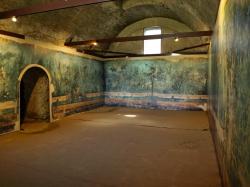 Rome - The Villa of Livia, home of the beloved wife and trusted adviser of the Emperor Augustus, has opened its doors to the public after being partially restored to its former splendor on the occasion of the 2,000-year anniversary of the emperor's death in 14 BC. "It was the imperial family's place of rest and relaxation," explained Rome Archaeology Superintendent Mariarosaria Barbera of the villa on in the Prima Porta suburb on the outskirts of Rome, which Livia Drusilla (37 BC-14 AD) made her domain after becoming Augustus' third wife. Legend has it that Augustus fell in love with Livia at first sight, while he was still married to his second wife, Scribonia, and she was married and six months pregnant. Augustus divorced his wife, and persuaded Livia's husband to divorce as well. The couple married three days after she delivered a son, waiving the traditional waiting period, and remained married for the next 51 years. The emperor was often on hand to visit Livia at the lovely villa whose famous illusionistic fresco of a garden view, in which all the plants and trees flower and fruit at once, has been removed and is on view in Rome's Palazzo Massimo. The villa's alternating mix of architectural and cultivated areas, open and enclosed spaces, would later become the model for Renaissance villas and can still be experienced in its sequence of rooms with sky-blue painted ceilings opening onto an internal garden where Livia grew her famous yellow daisies, fig trees, and herbs for her husband's tisanes, while hallways decorated in black and white geometric mosaics lead to the thermal baths and the guest rooms, their walls frescoed in Pompeian red. On the vast terrace overlooking Rome in the distance, restorers have placed 90 potted laurels, for Livia's villa was famed in antiquity for its laurel grove. At least a third of the villa remains to be excavated, but funds have run out, officials said.
Rome - The Villa of Livia, home of the beloved wife and trusted adviser of the Emperor Augustus, has opened its doors to the public after being partially restored to its former splendor on the occasion of the 2,000-year anniversary of the emperor's death in 14 BC. "It was the imperial family's place of rest and relaxation," explained Rome Archaeology Superintendent Mariarosaria Barbera of the villa on in the Prima Porta suburb on the outskirts of Rome, which Livia Drusilla (37 BC-14 AD) made her domain after becoming Augustus' third wife. Legend has it that Augustus fell in love with Livia at first sight, while he was still married to his second wife, Scribonia, and she was married and six months pregnant. Augustus divorced his wife, and persuaded Livia's husband to divorce as well. The couple married three days after she delivered a son, waiving the traditional waiting period, and remained married for the next 51 years. The emperor was often on hand to visit Livia at the lovely villa whose famous illusionistic fresco of a garden view, in which all the plants and trees flower and fruit at once, has been removed and is on view in Rome's Palazzo Massimo. The villa's alternating mix of architectural and cultivated areas, open and enclosed spaces, would later become the model for Renaissance villas and can still be experienced in its sequence of rooms with sky-blue painted ceilings opening onto an internal garden where Livia grew her famous yellow daisies, fig trees, and herbs for her husband's tisanes, while hallways decorated in black and white geometric mosaics lead to the thermal baths and the guest rooms, their walls frescoed in Pompeian red. On the vast terrace overlooking Rome in the distance, restorers have placed 90 potted laurels, for Livia's villa was famed in antiquity for its laurel grove. At least a third of the villa remains to be excavated, but funds have run out, officials said.
http://www.ansa.it/english/news/lifestyle/arts/2014/09/12/villa-of-livia-now-open-to-the-public_f815aac8-c302-49d8-b38a-680e8c03a504.html?